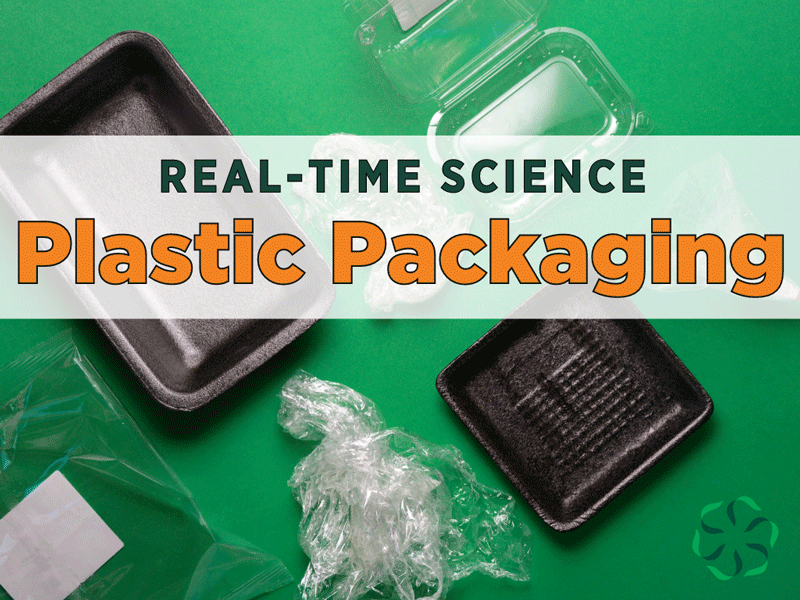In this post, we look at plastic and polymer-based packaging and explore the risks and benefits of these materials.
What is packaging? What does it do?
There are three core purposes of packaging materials:
- Protect products from contamination or damage.
- Contain and portion products.
- Communicate what’s in the packaging to the consumer.
Why is packaging important?
Storage and transportation are required to get food, beverages, and cosmetics from their sources to our homes. There are numerous points in our distribution systems where food and ingredients are stored, processed, packaged, transported, and then make their way into our lives for use.
Packaging keeps our foods, beverages, and cosmetics from encountering substances, pathogens, and contaminants that could potentially cause us harm or cause our foods to spoil prematurely (1).
What are contaminants?
There are three main contaminant categories:
- Natural
- Human-made
- Human introduced natural contaminants
Natural contaminants consist of plants, fungi, insects, bacteria, viruses, and more.
Human-made contaminants include some pesticides, residues, unwanted by-products like acrylamides (formed naturally during cooking), and environmental pollutants.
Human-introduced natural contaminants typically describe metals or other elements that can make their way onto our foods and water due to human activities like mining.
Is there a legal definition of plastic?
Plastic and polymer-based packaging are materials made from specific polymers designed and optimized to protect the food, beverage, or cosmetic products inside of it.
Plastic and polymer-based packaging includes materials like
- High-density polyethylene: detergent bottles, toys, and more
- Low-density polyethylene: plastic wraps, plastic bags, and more
- Polyethylene Terephthalate (PET): plastic water bottles, food packaging, and more
- Polypropylene (PP): yogurt containers, to-go containers. and more
- Polystyrene (PS): Disposable cutlery, foam cups, and more
- Polyvinyl Alcohol: laundry, dishwashing pods, and more
- Polyvinyl Chloride (PVC): plastic wrap, medication packaging, and more
Why use plastic and polymer-based packaging? Are there benefits?
Yes, manufacturers use plastic and polymer-based packaging because it offers many features that other materials cannot provide cost-effectively.
- Lightweight, yet durable: Unlike glass and metal, polymer-based packaging weighs significantly less and doesn’t readily shatter or dent. This makes transportation less expensive and energy-intensive.
- Protective: Plastic can provide a holistic protective barrier better than other materials like metal, paper, or glass. Without this protective barrier, foods, beverages, and cosmetics may be exposed to more contaminants and other harmful elements like excess light and moisture.
- Cost-effective: Plastic, overall, remains more accessible and more affordable to manufacture and use than glass, metal, and paper packaging products.
- Versatile: Plastic has numerous applications and can be molded into nearly any shape to keep the product safe and create usable, attractive designs.
- Recyclable and reusable: We can recycle and reuse many of the plastics on the market. However, as a society, we have more work to do to reduce plastic pollution.
- Innovative: Plastic materials allow manufacturers to innovate through technologies like active biofilms and biodegradable materials like polyvinyl alcohol. These technologies can reduce food waste, transportation costs, material use, and more.
Is plastic and polymer-based packaging harmful to human health?
We cannot find peer-reviewed studies supporting that plastic and polymer-based packaging approved for food contact by the U.S. Food and Drug Administration harms human health at current exposure levels.
However, some researchers believe that we must conduct a more thorough risk assessment process that looks more closely at the additives and other ingredients added to plastic and polymer-based materials.
What about microplastic and nanoplastic materials in foods, beverages, and cosmetics? Do plastic and polymer-based packaging cause them?
Plastic and polymer-based packaging can leave trace materials like microplastic and nanoplastic material on the foods, beverages, and cosmetic products it contacts. However, that doesn’t mean it’s causing harm.
The presence of an ingredient doesn’t mean it’s harmful. Many studies are underway to assess if and how microplastic and nanoplastic from plastic packaging may impact human health.
What else do I need to know about plastic and polymer-based packaging?
We need packaging materials to protect the foods, beverages, and cosmetics we use from contaminants, spoilage, and other outside elements that can ruin or make products harmful to our health.
Plastic packaging offers a way for manufacturers to keep the products we consume and use safe while being cost-effective, reducing food and ingredient waste, and decreasing transportation costs and fuel usage.
Regulatory guidelines prevent manufacturers from using unsafe materials that can leach harmful chemicals or have excessive residues that can cause harm. While small amounts of residue can be found on and in packaging, like with other types of potential contaminants and trace residues, the FDA provides toxicological guidance to ensure the packaging remains food and beverage safe (remember, the dose makes the poison).
Given the risk of food, beverage, and cosmetics spoiling and becoming damaged during transportation and processing, it makes sense to continue best packaging practices, including using plastic and polymer-based materials.
The good news.
Researchers continue to study the impact of plastic and polymer-based packaging materials to learn more about any potential adverse health outcomes from the materials. We continue to learn more about ways we can recycle plastics to help reduce pollution and environmental impact.
Additionally, innovation in green chemistry and polymer science introduces techniques and materials that can improve polymer packaging performance while reducing environmental impacts and continuing to protect human health.
If you have any questions about foods and ingredients, please reach out to us via email or submit your idea to us at go.msu.edu/cris-idea

